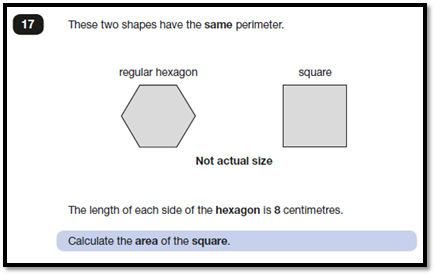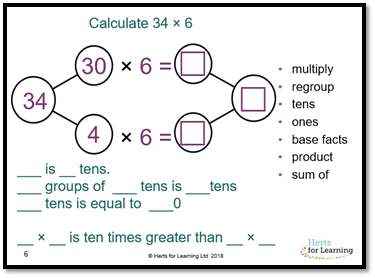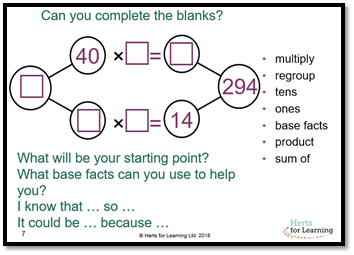Last year, I had the opportunity of working with two colleagues to write materials to support schools in developing effective fluency sessions. Their development began in a Hertfordshire school when a colleague was working with a subject leader who felt that mental strategies for addition and subtraction just weren’t getting enough ongoing rehearsal time and so the children were not developing a bank of strategies from which to choose when needed. From there… they grew… and grew… and grew! Since launching the resources following our first training day in June, I have also had the privilege to visit and work with schools who are using them.
But what are fluency sessions? Fluency sessions, or Maths Meetings, are short, snappy sessions, preferably daily, which allow children to retrieve previously taught knowledge in order to rehearse concepts. Brown, Roediger III and McDaniel note that although the “brain is not a muscle that gets stronger with exercise”, when taught concepts are practised over time, the knowledge of that concept will become stronger. “Retrieval strengthens the memory and interrupts forgetting.” (Brown et al 2014). You will notice that I am using the term ‘taught concepts’, as opposed to ‘learnt concepts’ as just because we have taught something, does not mean the children have confidently learnt it!
Consider the amount of knowledge that needs to be retrieved to answer this KS2 SATs question from summer 2019:

What do the children need to think about?
- What do I understand about perimeter?
- Do I know what a regular shape is and how this affects the properties of said shape?
- Can I calculate the total of 6 sides with a length of 8cm each?
- If I don’t know 6 x 8, what facts do I know that could help me?
- If the perimeter of both shapes is 48cm, how does this help me find the area of the square?
- What is area?!
Less than 50% of our last year’s Year 6 cohorts achieved 2 marks on this question. The calculations required aren’t tricky – even if 6 x 8 is not a known fact, pupils could use their knowledge of 5 x 8 and one more group of 8, or double 6 x 4 etc. We would expect most Year 6 pupils to tackle 48 ÷ 4 with confidence before finding the product of 12 x 12. The numbers involved aren’t challenging; it is the pupils’ ability to link the mathematical domains fluently that is needed here.
It is often my experience that when I work with teachers and fluency is discussed, fluency is seen as being confident and quick at completing arithmetic type questions – mainly based on the four operations and calculating with fractions. It is at this point that I will say that when I first started teaching Year 6, once a week – normally a Friday – I would reteach particular aspects of the KS2 curriculum, such as adding fractions with the same and then different denominators, before practising an arithmetic paper and then going through the answers. Now don’t get me wrong – there is definitely a need for children to practise procedures and formal methods and build up the stamina to complete the arithmetic paper – but it was in my second year of teaching Year 6 that I started using mini revision type sessions straight after lunch, 3 times a week, to allow children to practise concepts that we had covered in our daily maths lessons. For example, I may have put on the board a number such as 3,600 and some percentages that I knew that my class were confident with finding, such as 100%, 1% and 10%, and asked the children to find some more interesting percentages of 3,600. Children would discuss and share their methods – both efficient and inefficient were welcome! The next day, a new number would be in the middle of the board and children would complete the same task but be encouraged to think about strategies used the day before and how they might like to use them. These sessions lasted about 10 minutes and were by no means perfect but the children became increasingly confident at talking about their maths.
The fluency resources that we have developed aim to support teachers to revisit and rehearse concepts. Each year group has 3 PowerPoints (one for each term) and within each PowerPoint are 6-7 concept slides. Here is an example slide from Year 4’s spring term:

It is advised that this slide is used to firstly rehearse using a pictorial representation (part whole diagram in this case) to multiply a 2-digit by a 1-digit number. This is revision from Year 3. Vocabulary and speaking frames are provided to support the children with their explanations. Approximately 2 minutes are spent with the children discussing how they could find each part before combining to find the total product. 3-4 other slides are then used during the 10-15 minute session to rehearse other learning – perhaps including place value with decimal amounts and estimating the value of a mystery number on a number line when given the start and end number.
The following day, the same slides are used again but with small tweaks. Instead of the multiplier being 6, it could be 7. Instead of the start number being 34 (leading to the base facts of 3 x 6 and 4 x 6), more tricky base facts could be required, such as 37 (7 x 6 might be a less confident known fact for the class). When the children have had sufficient rehearsal of this slide then a more complex adaptation might be made the following week.

Initially children could talk about potential strategies and work out their starting points such as recognising that 294 has been regrouped into 14 and something. 14 less than 294 is 280 so 40 x something is 280. The slide could then be repeated the following day with no changes at all and instead the children could use what they have discussed yesterday to complete the blanks. To encourage that rich strategy talk, perhaps the question at the top of the slide should read ‘How could you complete the blanks’. Here the children are not only rehearsing their multiplication facts – I know that 4 x 7 is 28 so 40 x 7 is 280’, they are also reasoning about the relationships between base facts, finding an appropriate starting point and drawing out what they know. Fluency isn’t just about that fast recall of multiplication facts but being able to reason and articulate their mathematical thinking. But that’s another blog!
I had the pleasure of delivering the initial launch training during a staff meeting at Oxhey Wood Primary School and Kerry Kent, Assistant Headteacher and maths subject leader, is leading the implementation of fluency sessions across the school. Already, Kerry reports that she is seeing a difference. Kerry noted that all children, regardless of prior attainment, are included within the sessions and that the small daily adaptations support less confident children because they have seen similar the day before. Precise vocabulary is being developed with the use of the word lists, sentence stems and speaking frames. Kerry also commented on how rapid graspers are being challenged by being encouraged to use all the given vocabulary or to think of multiple strategies.
James McKenzie, Year 4 teacher and joint maths subject leader, is leading the development of fluency sessions at Abbotts Langley Primary School. James attended our first training day last June and shared the rationale and resources back at school. As well as the use of fluency sessions, James is also developing the use of pre-teaching as a strategy to support pupils who are working towards age related expectations. Currently, James uses these 15 minute sessions 2-3 times a week with pupils across the Year 4 cohort to allow children to rehearse a concept, tracking back to a point where the children are secure, before looking at possible misconceptions and gaps in knowledge that may restrict the access to what will be explored in whole class teaching. Key vocabulary is explored and a new method may be modelled to support the children’s confidence for the upcoming lesson. James reflected that: “These sessions are also of great benefit to the teacher, as they provide a practice run for the main lesson. I am able to discard things that may not have worked or add new questions that have come from the ‘pre-teach group’. There will be times when a start to the lesson can be used to provide a whole class pre-teaching opportunity, to cue pupils back in to prior learning, reactivating and rehearsing this before building on this in the main focus.”
Fluency sessions could prove to be a very useful tool for when pupils return to school. These short sessions based on previously taught concepts will help to reactivate learning, encouraging pupils to discuss what they remember, what they know, and to highlight what they may have forgotten. These sessions will also provide low threat assessment opportunities and can be used in readiness for future teaching and learning.
The suite of resources, which include 3 PowerPoints per year group, a start-up guide for leaders (including 3 videos) and a staff development launch session (staff meeting resource) are now available to purchase.
Professional development opportunity
Join us for face-to-face training at the Hertfordshire Development Centre to:
• consider the rationale for developing fluency sessions. Why do pupils need to be ‘fluent’ in maths and what do they need to be fluent with?
• explore possible structures and ways of organising sessions
• consider the appropriate content for fluency sessions, including what is appropriate for the year group and time in the academic year
• take away resources for a staff meeting to use with staff and a full set of (revised and updated) fluency session materials to use and adapt with each year group
Developing effective maths fluency sessions
References:
Brown P, Roediger III H, McDaniel M, (2014) Make it Stick: The Science of Successful Learning
STA (2019) Key stage 2, Mathematics Paper 2: Reasoning: Crown publishing



